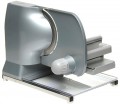Blade type
The type of blade that comes standard with the slicer.
All knives used in this category of kitchen appliances are circular, rotating, and the blade in them goes in a circle. But the shape of this blade can be different — it is in this parameter that the types of knives differ from each other.
—
Straight. Knives with a traditional straight blade are basic and affordable, yet with proper sharpening and skill, they can handle various slicing tasks effectively. They excel with products of uniform consistency like cheese but may be less effective for slicing non-uniform density items such as bread compared to knives with wavy or notched blades.
—
Wavy. Knives with a wave-shaped blade are more difficult to manufacture and more expensive than straight ones. On the other hand, they do an excellent job not only with homogeneous products, but also with those that have different density — like ham with a crust.
—
Serrated. Serrated knives have sharpening in the form of pronounced sharp teeth, resembling those of a circular saw. They are beneficial for slicing products with varying density, similar to wavy blades. Serrated knives are particularly effective for cutting vegetables and fruits with tough peels and soft cores, like tomatoes or peaches. However, these knives tend to be more expensive due to their specialized design.
No
...te that some models may come with several removable blades of different types. This allows you to choose an option depending on the situation — for example, cut the cheese with a straight knife, and put the wavy one only when really necessary, so as not to wear it out much.Blade diameter
The diameter of the blade of the knife supplied with the slicer. Knives are shaped like discs — accordingly, the diameter of the blade is actually equal to the diameter of the disc.
The larger the blade, the larger ingredients the device can handle at a time and the “larger” the cut slices can be. At the same time, in fact it is rarely necessary to use a slicer for very thick products. Therefore, even in the most “large-caliber” modern models, the knife diameter usually does not exceed 300 mm.
Min. thickness of slice
The smallest thickness of slices that a slicer can separate from the cut product.
The modern slicers, usually, allow you to adjust the thickness of the slices — an important feature in light of the fact that for different situations and products, the optimal thickness will be different. It is worth paying attention to the minimum thickness if the ability to cut graceful thin slices is important for you — for example, for serving a holiday table, on which food should be not only tasty, but also beautiful.
Pulse mode
Possibility of work of a slicer in the
pulse mode. In this mode, in accordance with the name, the knife of the device works nonuniformly — high speed alternates with short pauses. Pulse switching is well suited for working with dense and solid products: it allows you to develop a higher working speed than with uniform work, at the same time it does not allow overloading the knife and reduces the chance of jamming. However, even in such models, there is usually no question of cutting fruit pits or other equally solid ingredients — slicers are not designed for this in principle.

